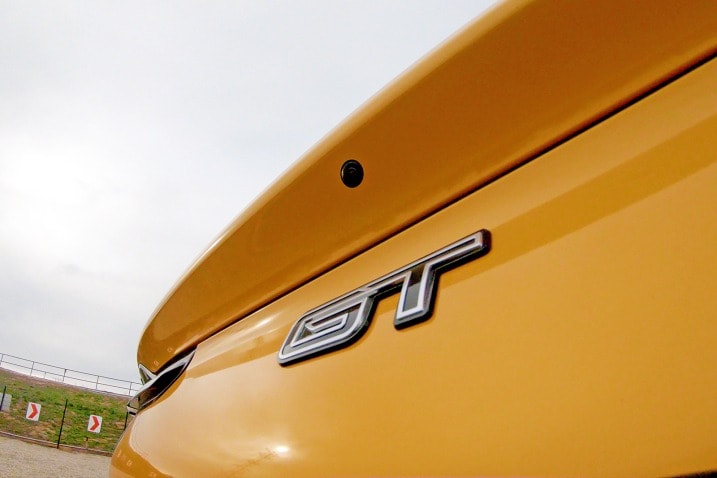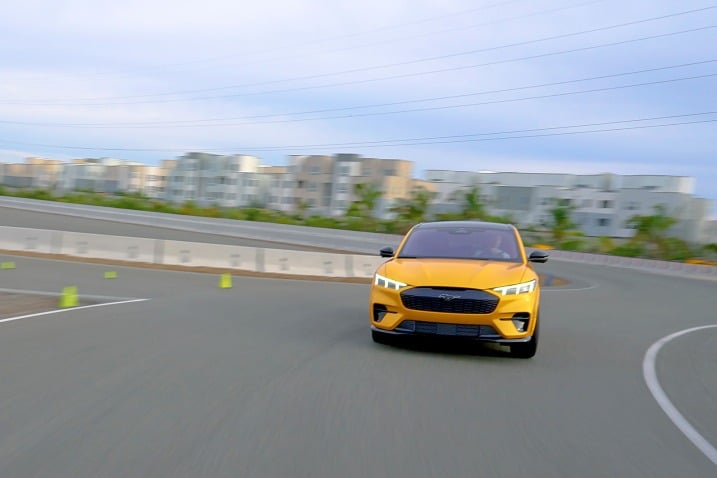- We tested the Ford Mustang Mach-E GT Performance Edition, which is the most potent and powerful Mach-E yet.
- The Ford eclipses its direct rival, the Tesla Model Y Performance, in terms of braking and handling, but the Tesla easily outguns it in acceleration.
TRACK TESTED: 2021 Ford Mustang Mach-E GT Isn't What We Expected
It's quick but it isn't fast
The Ford Mustang Mach-E debuted in late 2020 and immediately impressed, taking home the Edmunds Top Rated Luxury EV award for 2021. And that was well before we got our hands on the new Mach-E GT. Now, almost a year later, we've finally been able to take a GT-badged Mach-E to our test track.
Considering the huge performance gap between the regular Ford Mustang and the Mustang GT, we were excited to see what the Mach-E GT could do. As good as the regular Mach-E is, the GT must be way better, right? Not exactly, as it turns out. The Mach-E GT certainly delivered on some fronts, but it has a glaring issue that needs to be addressed.
What's the deal?
It has to do with acceleration, specifically past 60 mph. The table below compares the Mach-E GT to the Tesla Model Y Performance that Edmunds tested last year. (We're also including two other Mach-E variants from our testing files for context.) The Tesla hits 60 mph only a tenth of a second quicker than the Mach-E GT, but the gap widens considerably from there. Take a look at the speed the cars are traveling through the quarter mile. The Tesla is a full 13 mph faster and 0.6 second quicker than the Ford — a huge difference, especially given that the cars were neck-and-neck at 60 mph.
In fact, the Mach-E GT loses so much speed above 60 that it's barely going faster than the Mach-E Premium Extended Range at the quarter-mile mark. You really feel it from behind the wheel, too. The Mach-E GT feels like it hits a wall at about 80 mph, something you can track on the VBox GPS data loggers that we use.
Am I Ready for an EV?
- EV ownership works best if you can charge (240V) at home or at work This typically means a 240V home installation, but you could also have a similar setup at your office or other places your car is already parked for several hours each day. Don't expect a regular household outlet (120V) to suffice unless you've got a plug-in hybrid, in which case overnight charging at home is feasible.
- If you can’t charge at home, charging at a charging station could take at least 10x longer than at a gas station With public charging infrastructure still in its infancy, the user experience can be maddeningly inconsistent. Tesla owners tend to rave about the reliability and speed of the company's proprietary Supercharger stations, but rival DC fast options have thus far been plagued by technical issues and overcrowding. It's an evolving landscape and our best advice is to do your research on the available options for the EV you want to buy.
- Adding a 240V home charging system could cost up to $1,600 or more If your existing electrical service can handle the additional demands of EV charging, you may be able to add Level 2 charging at home for less than a grand, including installation. But your costs will multiply if you need to upgrade your electrical panel or add a dedicated circuit.
Test Car | Test Date | Temp | Weight | Acceleration 0-60 | Acceleration 1/4-Mile |
|---|---|---|---|---|---|
| 2021 Ford Mustang Mach-E GT Performance Edition | 11/1/21 | 65 deg | 4,997 lbs | 3.8 sec | 12.4 sec @ 102.6 mph |
| 2020 Tesla Model Y Dual Motor Performance | 6/8/20 | 79 deg | 4,419 lbs | 3.7 sec | 11.8 sec @ 115.6 mph |
| 2021 Ford Mustang Mach-E Premium Extended Range | 11/30/20 | 70 deg | 4,822 lbs | 5.2 sec | 13.6 sec @ 101.9 mph |
| 2021 Ford Mustang Mach-E Route 1 | 3/29/21 | 72 deg | 4,526 lbs | 6.5 sec | 14.7 sec @ 96.7 mph |
The Mach-E GT is even slower in the Unbridled Extended drive mode, which cuts maximum power a bit to help deliver more consistent lap times on a track. On the other hand, the Model Y still feels like it's hauling right through the quarter mile. The Mach-E GT's 3.8-second sprint to 60 is also worse than Ford's projected 3.5-second time, and unlike with gas-powered cars, we can't blame it on California's 91 octane fuel. We went so far as to retest the car since we were so unsure of the numbers.
We asked Ford what the deal was, and apparently the Mach-E GT can only deliver full power for 5 seconds, a real head-scratcher for a car aimed squarely at Tesla. Ford says the car isn't designed for drag strips. That's good, because anyone taking a Mach-E GT to one is likely to get smoked by any comparable Tesla.
There's good news, right?
Always. When it comes to braking and handling, the Ford outshines the Tesla. Emergency braking distances were shorter and more consistent with the Mach-E GT, actually improving a bit as the tires warmed up. Stops were 14 feet shorter than they were for the other two Mach-Es we tested, despite the GT easily being the heaviest of the bunch.
Test Car | 60-0 Braking Distance | Skidpad |
|---|---|---|
| 2021 Ford Mustang Mach-E Premium Extended Range | 106 ft | 0.99 g |
| 2020 Tesla Model Y Dual Motor Performance | 108 ft | 0.95 g |
| 2021 Ford Mustang Mach-E Premium Extended Range | 120 ft | 0.85 g |
| 2021 Ford Mustang Mach-E Route 1 | 120 ft | 0.85 g |
Skidpad performance — used to measure grip and road-holding — favored the Mach-E GT, too, by a not insignificant 0.04 g. While the Mach-E's steering isn't quite as quick as the Model Y's, it's still responsive. On the whole, the Mach-E manages its weight better. Combined with the improved braking, you're able to carry good speed through a corner, even if the Model Y can accelerate faster out of it. It's fun, mostly, but there's a little voice in the back of your head asking what Ford might have left on the table.
Edmunds says
While we wouldn't recommend taking a Mustang Mach-E GT to a drag strip, it's still fun when the road gets curvy. We just had higher hopes for something wearing both a Mustang logo and a GT badge.








 by
by